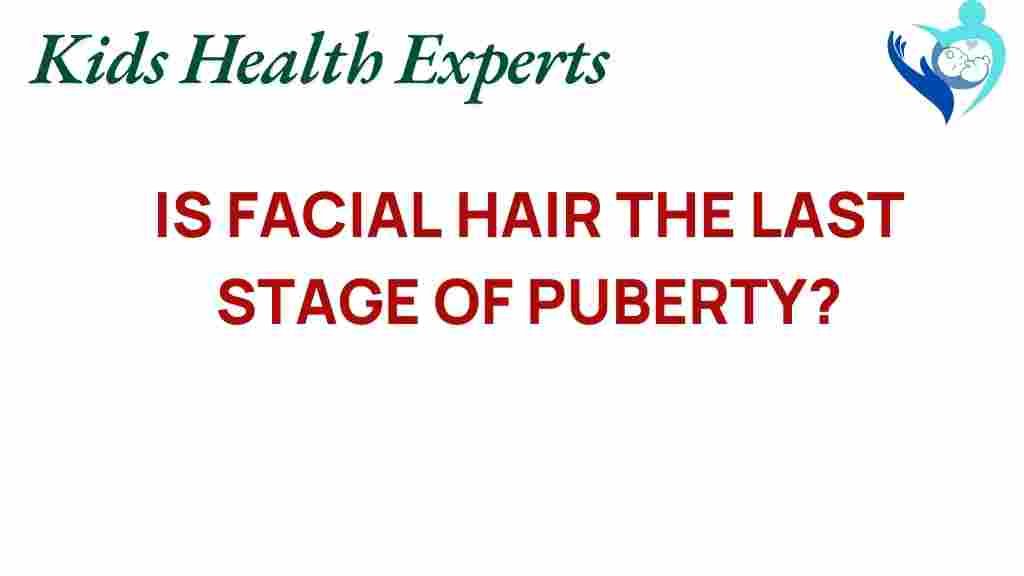Is Facial Hair the Final Frontier of Puberty’s Journey?
Facial hair is often considered one of the most visible and distinct markers of male development during puberty. As boys transition through adolescence, they encounter various changes, both physical and emotional, and the onset of beard growth is a significant milestone in this journey. But what exactly triggers this change? In this article, we will explore the intricacies of facial hair development, the role of hormones, and how it fits into the broader context of puberty stages and adolescent changes.
Understanding Puberty and Its Stages
Puberty is a complex process that marks the transition from childhood to adulthood. It encompasses a series of physical and emotional changes caused by hormonal fluctuations. For boys, puberty typically begins between the ages of 9 and 14, though it can vary widely. The stages of puberty can be summarized as follows:
- Stage 1: Pre-puberty (ages 9-10)
- Stage 2: Early puberty (ages 11-12)
- Stage 3: Mid-puberty (ages 13-14)
- Stage 4: Late puberty (ages 15-16)
- Stage 5: Post-puberty (ages 17 and up)
During these stages, boys will experience various changes, including voice deepening, body growth, and, notably, the development of facial hair.
The Role of Hormones in Facial Hair Development
Hormones play a crucial role in the changes experienced during puberty, particularly in male development. The primary hormones involved in the development of facial hair are:
- Testosterone: The main male sex hormone that is responsible for many physical changes during puberty, including increased muscle mass, body hair, and facial hair.
- Dihydrotestosterone (DHT): A derivative of testosterone that specifically influences hair follicles, leading to beard growth.
As boys enter puberty, the body begins to produce higher levels of testosterone. This surge in hormones stimulates hair follicles on the face and neck, prompting the development of facial hair. The timing and thickness of beard growth can vary significantly among individuals, influenced by genetics, ethnicity, and overall health.
Facial Hair Growth Timeline
The timeline for facial hair growth can differ widely. Typically, facial hair begins to appear during the early stages of puberty, with a few common patterns:
- First Signs: Fine, soft hair (often referred to as “peach fuzz”) usually appears around the upper lip and chin during Stage 2.
- Increased Growth: As boys progress to Stage 3, the hair becomes coarser and darker, often spreading to the cheeks and jawline.
- Full Beard: By Stage 4, many boys can grow a full beard, although some may continue to develop facial hair into their early twenties.
This gradual progression underscores that facial hair is indeed the final frontier of puberty’s journey for many boys, often occurring after other significant changes.
Common Adolescent Changes During Puberty
Facial hair is just one of many changes boys will experience during puberty. Other common adolescent changes include:
- Growth Spurts: Rapid increases in height and weight are common.
- Voice Changes: The voice deepens as the larynx grows.
- Body Hair: Hair begins to grow in other areas, such as the chest, underarms, and legs.
- Skin Changes: Increased oil production can lead to acne.
- Emotional Changes: Hormonal fluctuations can cause mood swings and increased emotional sensitivity.
Understanding these changes can help adolescents and their families navigate the complexities of this transformative period.
How to Care for Facial Hair During Puberty
As facial hair begins to grow, it is important for young men to learn how to care for it properly. Here are some tips for maintaining facial hair during puberty:
- Regular Washing: Keep the facial hair clean by washing it regularly with mild soap.
- Moisturizing: Use a beard oil or moisturizer to keep the skin underneath hydrated and to prevent irritation.
- Trimming: Regular trimming can help maintain a neat appearance and promote even growth.
- Consult a Barber: Seeking professional advice from a barber can be beneficial for learning how to shape and style facial hair.
Learning these grooming habits early on can help young men embrace their facial hair journey with confidence.
Troubleshooting Common Issues
As with any aspect of development, there can be challenges associated with facial hair growth. Here are some common issues and tips for troubleshooting them:
- Uneven Growth: It’s normal for facial hair to grow unevenly during the early stages. Patience is key, as growth will become more uniform over time.
- Itchiness: Newly grown facial hair can cause itchiness. Applying moisturizer can alleviate this discomfort.
- Acne: Increased oil production can lead to acne. A gentle skincare routine can help manage breakouts.
- Insecurity: Some may feel self-conscious about their facial hair. Open discussions with friends or family can provide support.
If concerns about facial hair and puberty persist, consulting a healthcare professional is advisable.
Conclusion
Facial hair indeed represents the final frontier of puberty’s journey for many young men. This transition is not just about the physical appearance but also signifies a deeper metamorphosis into adulthood. Understanding the hormonal changes that drive beard growth, recognizing the stages of puberty, and embracing the associated adolescent changes can empower young men to navigate this period with confidence.
As they learn to care for their facial hair, they should also remember that every individual’s journey through puberty is unique. Patience, self-acceptance, and support from family and friends are essential components of this transformative experience.
For more information about puberty and adolescent changes, you can visit this resource. If you are looking for tips on grooming and maintaining facial hair, check out this guide.
This article is in the category Conditions and created by KidsHealthExperts Team
